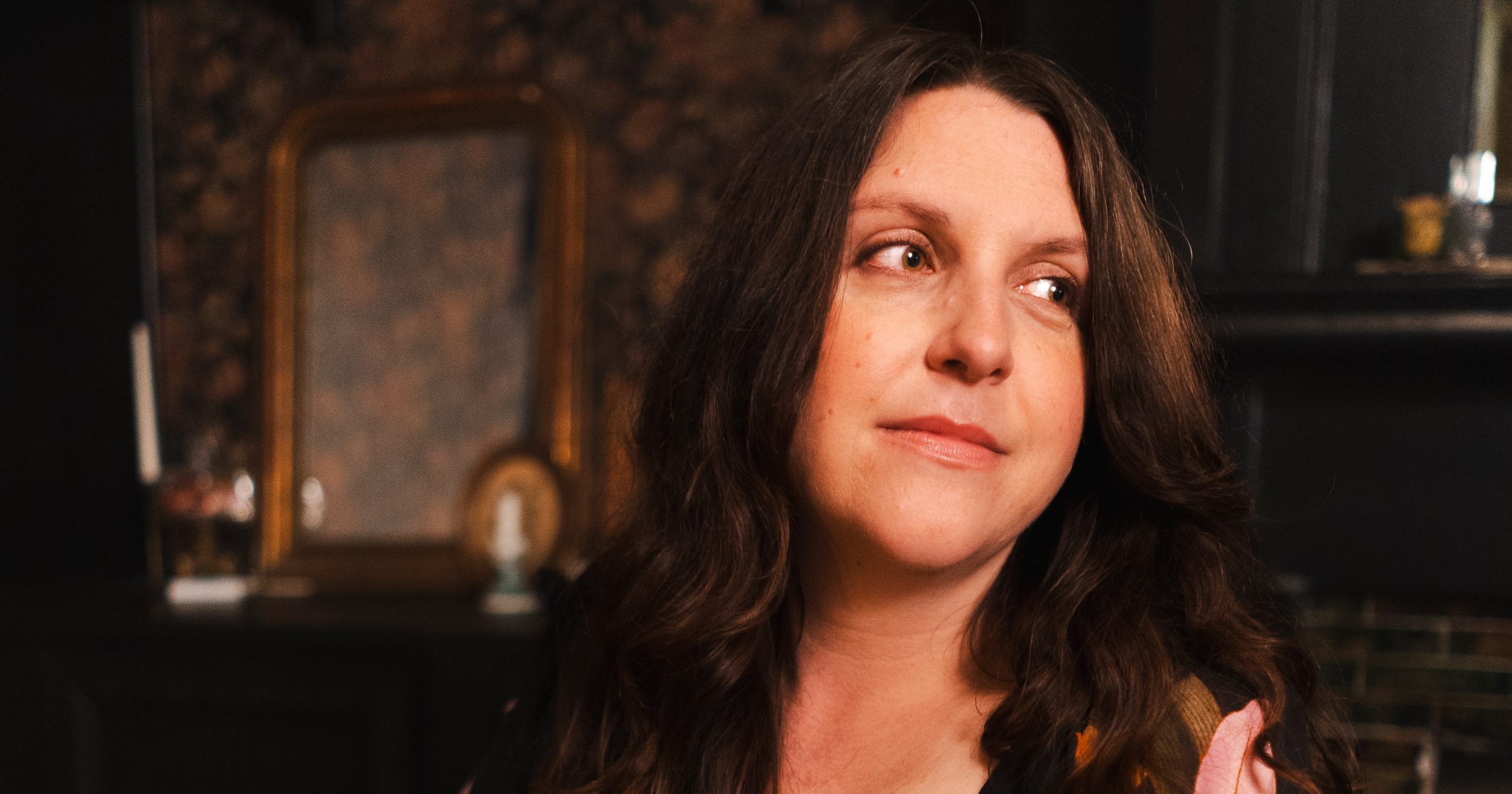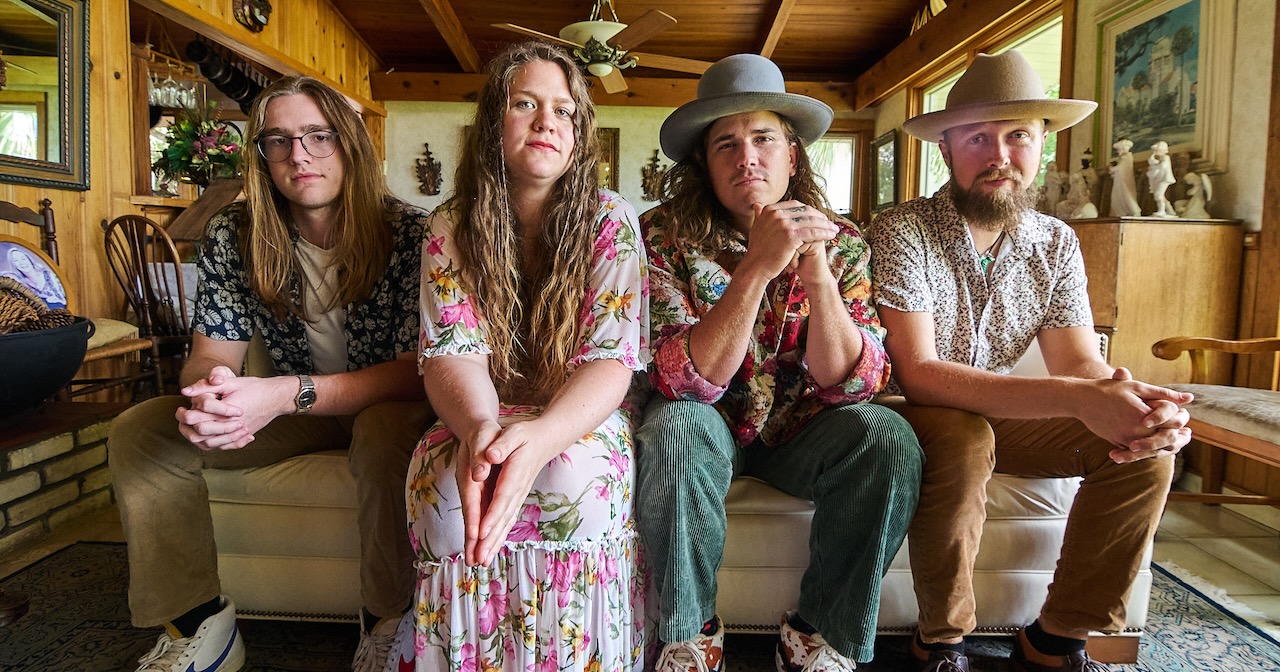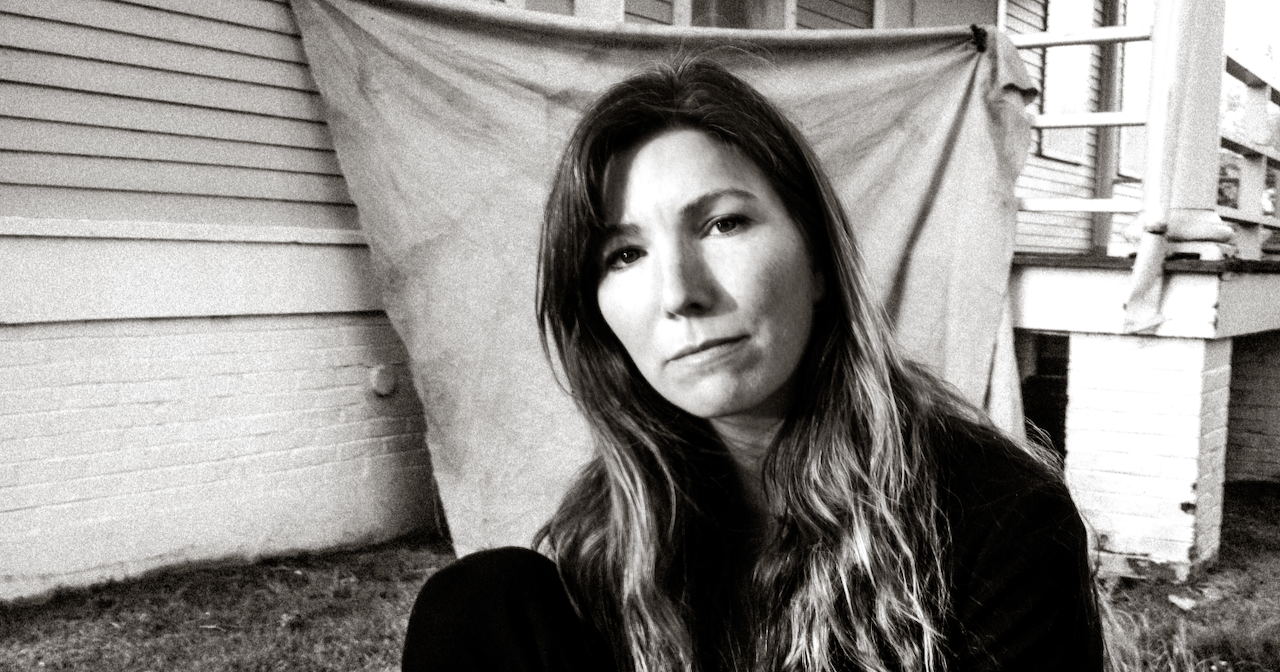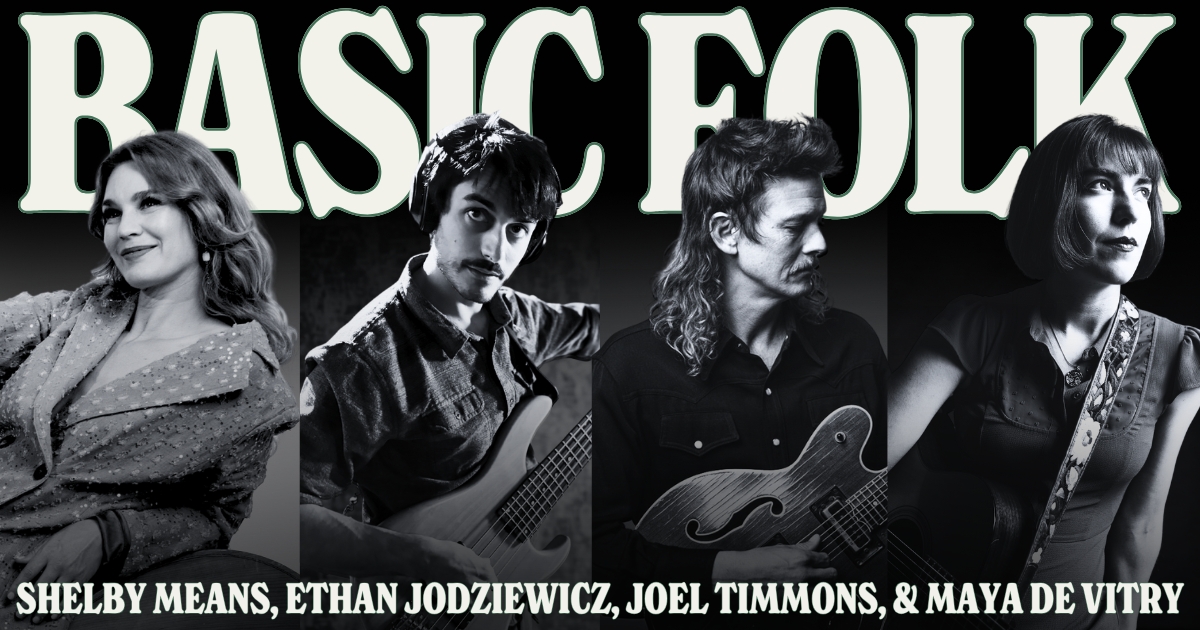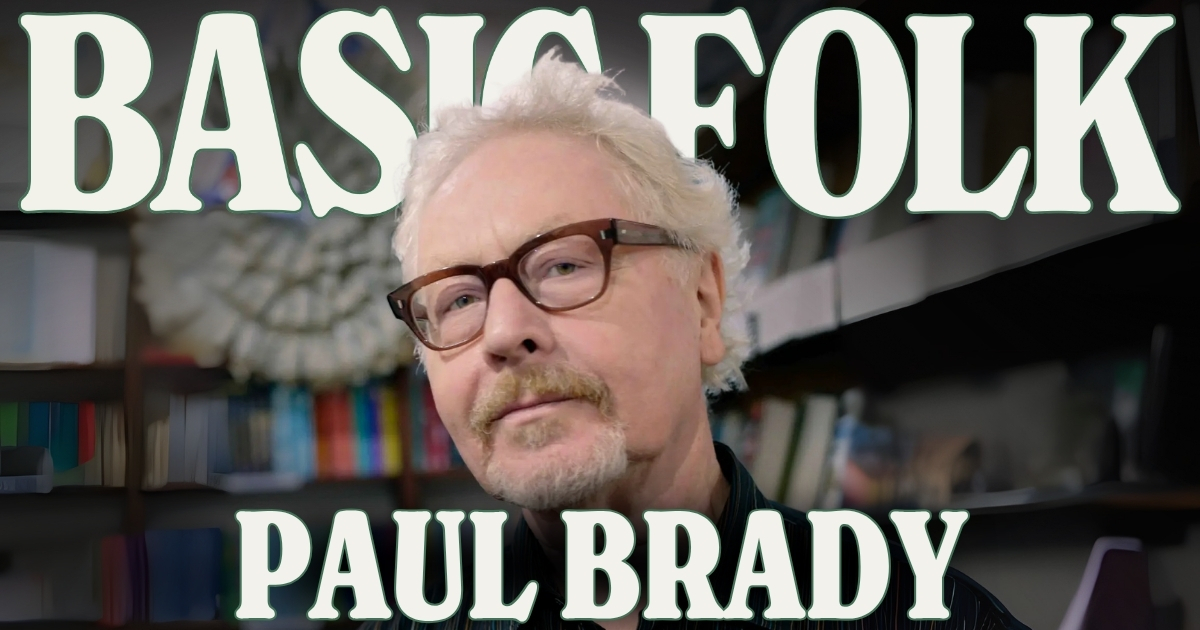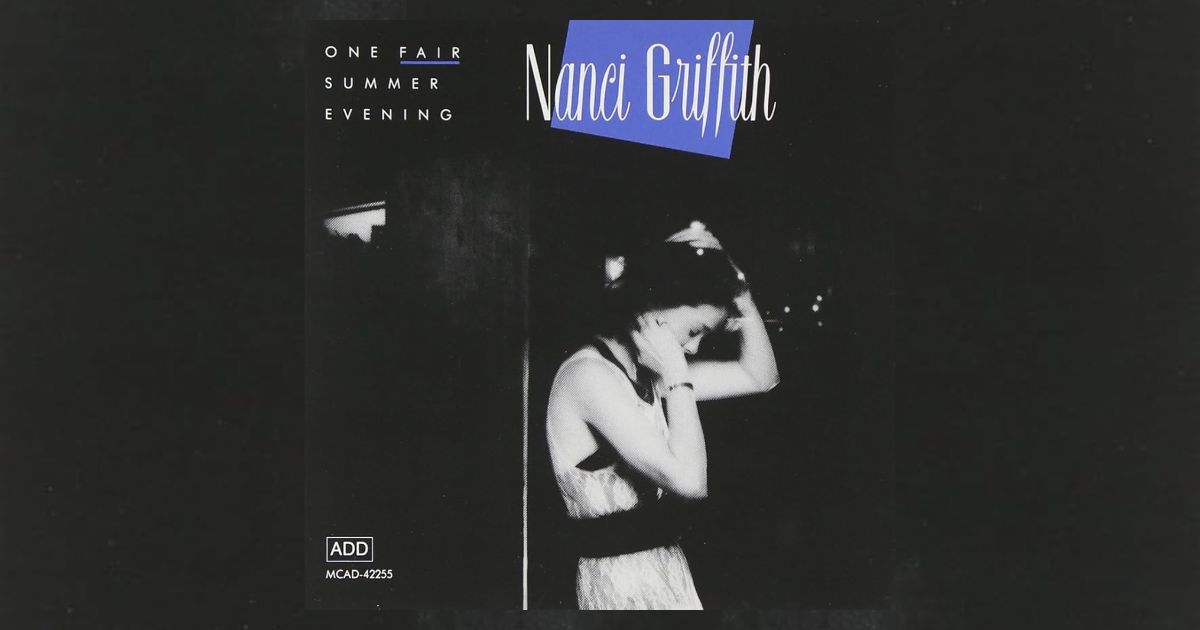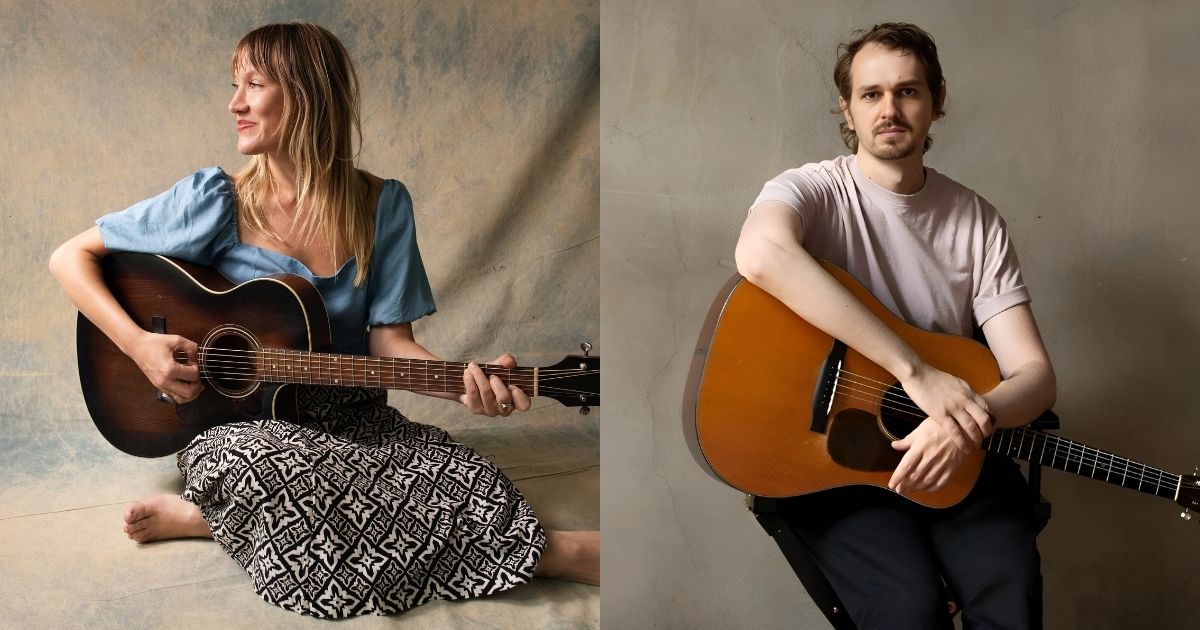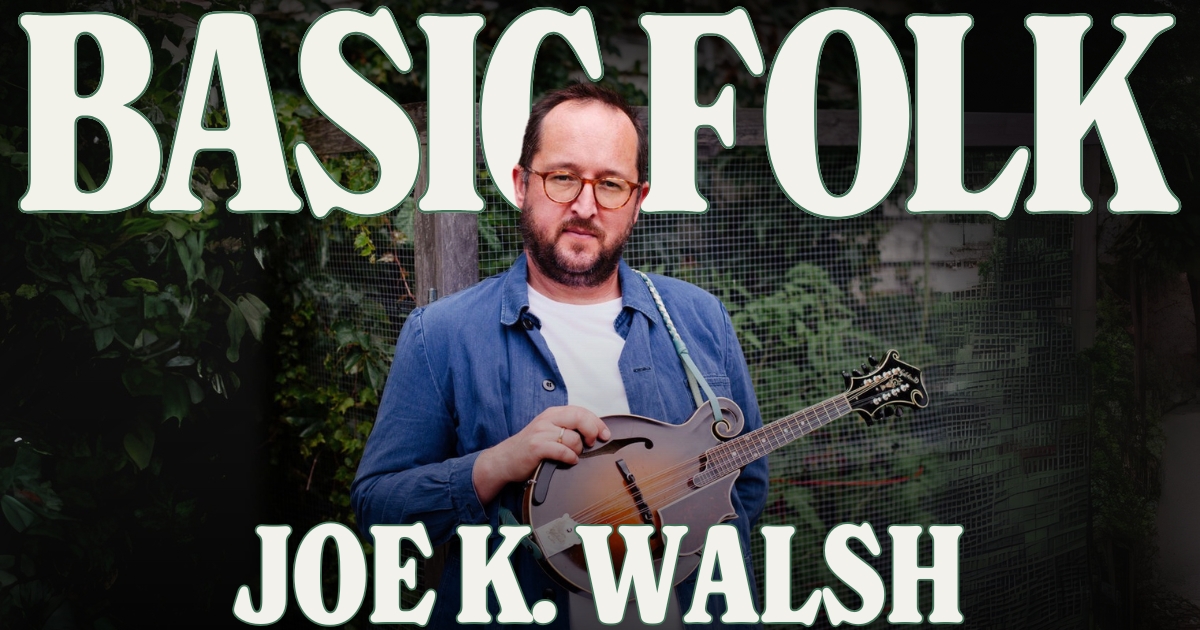Tag: Folk
Win Tickets to I’m With Her
Artist of the Month:
Caroline Spence
Author and artist Jenny Odell begins her impeccable book, How to Do Nothing, immediately driving to the heart of the matter:
Nothing is harder to do than nothing. In a world where our value is determined by our productivity, many of us find our every last minute captured, optimized, or appropriated as a financial resource by the technologies we use daily.
The book is a striking, heartfelt argument for a realignment of societal and personal priorities that decenters social media, the “attention economy,” and the ways each of our individual “rat races” have now penetrated every aspect of our own lives and our each and every waking moment. In Chapter 1, “The Case for Nothing,” Odell continues,
Currently, I see a similar battle playing out for our time, a colonization of the self by capitalist ideas of productivity and efficiency. … The removal of economic security for working people dissolves those boundaries – eight hours for work, eight hours for rest, eight hours for what we will – so that we are left with twenty-four potentially monetizable hours that are sometimes not even restricted to time zones or our sleep cycles.
These paradigms of and assumptions about “productivity” immediately jumped into my mind when I first heard singer-songwriter Caroline Spence’s lovely new album, Heart Go Wild. Released August 29, it marks Spence’s return to independently releasing music – on her own terms and retaining ownership of her own intellectual property (and the productivity that birthed it).
Over 12 original tracks, Spence is meditative and introspective, angry and tender, grateful and underappreciated, clamoring for justice and toying with the idea of giving up. There’s self-cajoling and there’s self-acceptance. There are aspirations, too, but the undercurrent of this collection isn’t ambition or climbing Music Row ladders or seeking any sort of superlative recognition. More than perhaps any of her other delicious albums – which also carry through many of these same themes – Heart Go Wild seems to be an exercise in songcraft, music-making, and album production that’s more in the vein of “doing nothing” than “doing everything, for everyone, 100% of the time.”
So, while these songs will surely elicit tears, spur daydreams, trigger longing, and untether dozens of emotions, overall they feel like one long, therapeutic sigh. A “deep breath out” to purge years of being underestimated or overlooked or underserved by record label execs, an exhale to eliminate any traces of ambition only for ambition’s sake, and to say goodbye – once and for all – to making art in order to meet the expectations (or profit margin targets) of others.
Since Spence’s most recent prior album, 2022’s True North, the shape of her professional life and network isn’t the only way her day-to-day has changed. She married her life partner, together they started a family, and the rocky relationship she had with the music business and its executives was just one facet of many in a deep self-searching and realignment of her musical and artistic priorities.
You can hear this shift in – or perhaps, recovery of – her values system in each of these songs. Spence has learned that “doing nothing,” that is, working outside of the machinations of the music industry, has always been her preferred method. And, just as she tends her bulbs, wildflowers, and hydrangeas, rain by rain, day by day, season by season, she now brings the same sort intention to her entire music-making process.
Odell continues in How to Do Nothing, “Our very idea of productivity is premised on the idea of producing something new, whereas we do not tend to see maintenance and care as productive in the same way.”
These songs – whether “Confront It,” “The Sound of You,” “Soft Animal,” “Dried Flowers, Old Habits,” and many others on the LP – indicate a deep, in-her-bones understanding that maintenance, stillness, rejuvenation, and feeding one’s soul – and the souls of your loved ones – is always productivity. Does it pad the pockets of suits in Nashville board rooms? Certainly not. Can it birth one of the best albums of the year? It does seem so!
Heart Go Wild is full of redemption – and the labors required to bring about a “blank slate,” a fresh starting point, and a re-solidified foundation. It may not feel like a totally new turn for diehard Spence fans (either sonically or textually), but there is still a palpable sense of the dust being shaken off and a new and endless creative horizon coming into view – tempting, tantalizing, and ready for Spence to gallop off toward.
As often as these songs are sad and self-challenging they are bold and dripping with agency. There are many moments of looking back and asking, “Why? How?” and “Did it need to end up this way?” Which are that much more impactful alongside their counterparts that say, “I know who I am,” “I know where I’m going,” and “I know who I’m bringing with me.”
Heart Go Wild places at its center – first and foremost – the loved ones Spence will elect for her songwriting and album-producing “board room” in her mind: her loving husband, their child, her family, her friends and peers, and her endlessly faithful rescue dog, Roxy. Spence is looking forward, utilizing the clarity she did gain from looking back to establish a new sort of workflow.
Externally defined productivity clearly won’t have the power over this critically acclaimed and musician-and-artist-beloved singer-songwriter anymore. (Though this writer is skeptical it ever truly did have that power to begin with.) Spence, like many of us, has spent the last few years, especially post-COVID and in the midst of growing her family, to learn how to constructively do nothing.
Now, with this stunning set of songs, she’s passing along those lessons to us. And, as we’ve already established, this kind of nothing isn’t nothing at all, no matter how hard it is to do. This kind of doing nothing is doing everything.
Caroline Spence is our Artist of the Month! Check out our Essential Caroline Spence playlist below and stay tuned as we share content on Spence, her music, and her songwriting throughout the month. We also have a very special “in conversation” interview feature with Spence and Lori McKenna. Follow on social media, too, as we dip back into the BGS archives for all things Caroline Spence all month long.
Photo Credit: Kaitlyn Raitz
BGS 5+5: Remedy Tree
Artist: Remedy Tree
Hometown: Umatilla, Florida
Latest Album: Beyond What I Can See (releasing September 12, 2025)
Personal Nicknames: Abigail – Abi; Gabriel – Gabi; Nathan – NayNay; Isaac – Dehydrated And Decaffeinated.
(Editor’s Note: Answers provided by Gabriel Acevedo)
What’s your favorite memory from being on stage?
2024 EMS Spring Bluegrass Fest in Brooksville, Florida, with Chris Henry and Steve Leonard. We got to open for the SteelDrivers and worked tirelessly to put on our best show and production together with props, a late night pre-show, etc. Watching it come to fruition with the perfect vibe and watching everyone dance was very inspiring.
What rituals do you have, either in the studio or before a show?
I used to not have any and it started to affect the show, coming up feeling unprepared and frantic. Nowadays I try to have about half an hour before shows to slow myself down. Laying on my back on the ground, doing vocal warmups. Also ashwagandha gummies. We all kind of just hang out and relax and try to be as chill as possible.
What’s the most difficult creative transformation you’ve ever undertaken?
Becoming a bluegrass band recognized in the industry as such. Funny enough, this upcoming album exemplifies the most difficult creative challenge: Creating a proper bluegrass album while staying true to our flavors and background. Remedy Tree was born within the old-time and folk world. Bluegrass has a formula that must be learned and perfected and that’s one reason why it’s so beautiful. Being on a bluegrass label having recorded much of the album live feels amazing. It’s been so surreal.
What’s one question you wish interviewers would stop asking you?
“So where does your band name come from?” This is unfair, I know, but it’s the most frequently asked question and I never have a good answer for them. The name came from me brainstorming names for hours and using a series of random word generators. I didn’t even like it at first, and then it stuck!
What is a genre, album, artist, musician, or song that you adore that would surprise people?
Being Puerto Rican, I think Latin elements will enter our music sometime, subtly. I don’t know when, but that’s a part of me that is bound to show itself at some point.
Photo Credit: Tucker Joenz
Anna Tivel Makes Poetry in Music From Poetry in Nature
There is something woodsy and nature-rooted about Anna Tivel’s songwriting. It calls to mind mountain hiking, tall pines, mushroom foraging. The clink of a water bottle against a caribiner. The gentle tiptoe sound of dew dropping from treetops. Maybe it’s Oregon that’s seeped into her bones. Maybe it’s just the way her intrinsic poeticism steers things.
Listening to Tivel’s music tends to conjure the words of other writers. Consider some of the final lines from Barbara Kingsolver’s Prodigal Summer:
“Solitude is only a human presumption. Every quiet step is thunder to beetle life underfoot; every choice is a world made new for the chosen.”
Or, consider the poetry of Wendell Berry or Mary Oliver or Andrea Gibson. Each seemed to have plucked their pieces from shrubs and vines – or at least from the air around their foliage. Indeed, some of these names came up in our recent conversation with Tivel about her new album, Animal Poem, which drops August 29 on Fluff & Gravy Records.
Much like a walk through the woods, Animal Poem offers listeners a pathway toward retaining their humanity in a world that can feel inhumane. Though Tivel notes she began writing this album two years ago, she was conscious of the shifting geopolitical landscape and the way the chaos in the news might – or might not – echo into people’s private lives.
In the end, she suggests that life is mostly made of small moments between people who are guided by love and who are trying to understand one another. Those are the moments of dissonance where our commonalities have the best chance of prevailing. To hear Tivel tell it, that is the basis of her job as both poet and songwriter.
With so much going on in the world geopolitically, so many people are struggling with how to make art and why to make art and, of course, feeling compelled to continue to make art. But there’s this existential part of it that I feel like you’re addressing on this album. Maybe also in the creation of this album, which I’m guessing was recorded well before what’s happening today, and will be different from what will be happening when we publish it.
So, when you think about this album now, and what you were working through with these songs in that moment, how has it aged in your mind?
Anna Tivel: That’s funny, I was thinking today how, in this particular year so far, I’m having trouble [writing songs]. I’m having a lot of trouble finding the core of what I mean. I always feel like writing is this search for something a little beyond your understanding. You’re just moving through the world kind of trying to express what you see and what you’re learning and what you’re reaching for. And I’ve been finding, in this particular moment, it’s just so loud and it’s so tangled. I’m writing a lot of angry things that I will never play, [about] not understanding and not even knowing what to reach for to try to understand.
This album was all written like two years ago now, in a state of the world not dissimilar from this one. I was reading a lot of Wendell Berry and just thinking about big, overarching systems and how impossible it is for those to stay about people. [I was thinking] about the earth and kind of thinking about how these smaller communities … function and how things ripple outward. But, the really small things, like your family or your neighborhood. Power lies in these very mundane but magical lives we’re living. How we’re touching the person across the street from us or how we’re figuring out our own hearts, and how powerful that is in the overarching, huge system that [can] become very inhumane so easily.
I think there’s a lot of that there – a lot of love and immense, wild power. All these things are coming out of the technological wavelength that we’re on. And then things like love [that] just can’t be snuffed out.
As you were talking about what we’re reaching for, and the small things, I kept thinking about this image at the end of this record, in the song “Meantime.” The swing set that nobody used and this family that, maybe there was abuse, but the dad built the swing set. Nobody went out to play on it, and they left, and the swing was still there, blowing in the wind.
A swing doesn’t know what it’s reaching, but it’s always there to lift you. What a beautiful thesis that it is for this record, coming as it does, at the end. Can you talk a little bit about that song, “Meantime,” and your decision to place it second to last? Does it feel to you like that’s what this record was reaching toward? I’m always interested in how sequencing tells the story.
Sometimes [sequencing] is really just meaning-based, or it’s sort of sonically based. I really liked the idea of this record kind of starting with this song that expands as much as the whole country. And then going all the way down to the last song, [which] is just very quiet, about love between two people, or what it is to build the language of love with the people nearest to you. I like there to be some kind of journey on a record, where you’re taken through different stories and different lives, for there to be some sort of arc.“Meantime,” to me, feels [like] that’s what I’m trying to say, but it takes place in a very small image. It’s one neighbor. There’s always a lot of neighbors in my music. [I’m a] very voyeuristic neighbor, probably.
There’s this feeling on the record, I think, that we hold all these things and we’re contributing to all these things – such pain and also such beauty. And we’re all sort of trying to separate ourselves from each other [and] from these big forces.
You can recognize yourself in everything, both the good and the bad. But inside of me is so much love and there’s so much cruelty and so much confusion. And becoming part of a family or a community – or a global community – it’s almost like the deeper you [go,] the more you recognize that you are just like everybody. You hold all those things and they hold all those things, even if they feel ugly or small or huge or powerful, they’re in there.
You’re reminding me of the poem by the late, brilliant Andrea Gibson. When I first heard their line, I actually thought of you. And then listening to this album, it came back to me.
The line is, “Do you know how many beautiful things can be seen in a single second?” It’s from the poem, “In the Chemo Room…” It’s thoughts from chemo, which is such a hopeless, awful thing, theoretically. And yet, all of Andrea’s work is so full of hope. I feel like that is so true to what this album conjured for me. I’m wondering if you have any kind of relationship with their poetry or if you were even aware of that parallel.
Yeah, I wish. I wanna take it in, because my good friends in Portland were just telling me to go read their work. I haven’t yet, but I resonate a lot with that. Like, you can just look all around you and see horror upon horror. [But] we are stunningly alive. Full of love and mystery, all at the same time. You’d die if you couldn’t hold that. You can kind of lean in either direction, or you can kind of like just sit there in all directions at once. That’s the journey of the whole thing.
While I’m bringing up poets, you mentioned Wendell Berry. One of my other favorite lines is from him: “Be joyful though you’ve considered all the facts,” Right? Like, this whole idea that we are animals among animals on this planet. Everything’s brutal – and there’s joy. And there’s love, you know. This is such a vital part of what every poet says, right?
There’s a song on here called “Animal Poem,” but the fact that you chose that phrase as the title of the album seemed to resonate. What was it about, to you, to choose those two words as the title of this project?
It’s exactly that. I feel very much like I want to be another being on the earth [who is] trying to express all those things at once, that everybody’s feeling, going through, and finding ways to say to each other.
There’s so many ways that we hold the word “animal”: Wild, untethered, maybe dangerous, maybe instinct[ive], maybe disturbing. … A poem is such an intentional, beautiful way to capture a small part of being. I like the idea that maybe this whole thing is just [us] running around confused, trying to find a little beauty, in what often appears to be utter chaos.
But where is the line, in your mind, between poetry and music? Is there any difference? Is it something intrinsic to the piece? Or, how do you decide what gets music added and what stays a poem?
Yeah, maybe I just think it all comes from the same place – the raw urge to express something. The way that music, or any art form, allows you to express it a little more honestly, because it’s not so straightforward.
When you can live outside the exact facts and use all the colors and the sensory details and emotion of a thing, sometimes that feels more true than being like, “Ted went to the store and bought an egg.” You know? There’s all the other things that happened in that moment that informed the way Ted’s heart was moving, that can be more readily got-at with art. There’s all these ways that people do that.
Ted’s egg was actually quite an experience for him.
Yeah, I mean, why did he go for just one egg? That’s my question.
There’s only one egg left. Poor Ted.
Logistically, when it came to making this record, you noted that it was a group of people in a room just kind of playing together. Was there rehearsal? How many times did everybody else hear these songs? And what was the creative process in that circle?
It was really free. I loved making this record. It felt, to me, like a bunch of freedom. Hearts in a room, just having our thing.
Some of us had toured together a little bit, so we played some of these songs in various ways. Some were new. We sort of just sat and played together for a day or two beforehand. We tried really hard not to make parts. [We were] really trying to at least get comfortable with the forms, so you know where the bridge lives, so it doesn’t surprise you. But [we didn’t do] so much that people settled into things.
Then we just sat in a circle. We didn’t wear headphones, which I loved, and we put my voice through a little monitor in the middle of the room. I’m fairly quiet, so everyone could at least hear the words. We mixed ourselves and just played music in the room together. There was no turning yourself up in the headphones or adding reverb. It just was what it was.
That felt really free. It felt like we forgot we were making a record. Just trying to feel the thing in the moment. I love this group of people. I’ve done a lot of touring with [them] over the years. [I’ve] known them a long time and really respect their musicality, but also their spirits.
Photo courtesy of the artist.
Basic Folk: Maya de Vitry, Ethan Jodziewicz, Joel Timmons, Shelby Means
Maya de Vitry, Ethan Jodziewicz, Joel Timmons, and Shelby Means are on Basic Folk today talking about their new collaborations. Maya produced both Shelby and Joel’s debut solo albums this year; Joel and Ethan play in Maya’s band; and the two couples (Joel & Shelby are married and Ethan & Maya are partners) are all very close friends. They met in Nashville, where Maya & Ethan still live, while Joel & Shelby live in Charleston, South Carolina. Joel talks about the huge gesture Shelby made in leaving Nashville behind for his hometown of Charleston. He also talks about the elated feeling they both got when Shelby, who also used to tour with Della Mae, got the chance to play upright as a member of Molly Tuttle & Golden Highway.
LISTEN: APPLE • SPOTIFY • AMAZON • MP3
Big themes of this friend group include trust, lifting each other up, and being one another’s “vibe coaches.” In our conversation we talk about choosing love, connecting with your music friends in non-musical ways, and, of course, the most epic hair in Americana: Joel Timmons and his mullet. The group shares insights on how they are still close and able to connect and spend time with each other despite the distance. Short flights and drives are worth it when you’ve got friends like this.
Photo Credit: Shelby Means by Hunter McRae Photography; Ethan Jodziewicz by Joel Timmons; Joel Timmons by Scott Simontacchi; Maya de Vitry by Kaitlyn Raitz.
Basic Folk: Paul Brady
Bob Dylan once called Paul Brady a “secret hero” and meant it as a compliment. The Irish songwriting legend has not been bothered by the fact that his profile has not risen as high as some of his peers. Starting off in the world of traditional Irish music, Brady spent time in the hugely influential Irish group Planxty until they disbanded in 1975. After that, he and bandmate Andy Irvine recorded a record of trad music together. In 1981, Brady released an album of original songs titled Hard Station that was based on his experience of growing up during The Troubles in Northern Ireland. It was a huge left turn for him stylistically and in being so personal with his writing. After that, Brady’s songwriting career took off; he has written songs for Bonnie Raitt, Santana, Tina Turner, and many others.
LISTEN: APPLE • SPOTIFY • AMAZON • MP3
In our Basic Folk conversation, Brady reflects on his upbringing and how music served as his reliable companion. He also discusses his parents’ artistic influences, particularly his father’s passion for acting and how it shaped his own stage performances. We touch on themes of perfectionism, impostor syndrome, and the inherent pressures of the music industry. Additionally, Paul talks about his latest massive box set, The Archive, which features rare demos, live recordings, and unique collaborations, offering a comprehensive look at his extensive body of work.
Photo Credit: Stuart Bailie
One Fair Summer Evening…
My fifth grade teacher, after announcing pop quizzes, would, without fail, remind my panicked classmates and I sitting at our desks to “Look down in desperation, look up for inspiration, but do not look side-to-side for information.” A memorable way to keep ten-year-olds from cheating on each other’s exams. There’s something about the adage that’s stuck with me twenty-five years on.
To this day, if I’m feeling desperate or helpless, my head droops down, oftentimes collapsing into the palms of my hands. I still also look up for answers to the unanswerable, the unknowable, or as Mrs. Schock put it, for “inspiration.” Sat at my desk once again, reading about last month’s flooding in Texas on this country’s 249th birthday, my head automatically fell into my hands and, just as quickly, my eyes lifted their gaze upwards. Above my computer, nestled in the Napa Valley Wooden Cassette Rack, something caught my eye, the audio cassette of One Fair Summer Evening by Nanci Griffith.
The GRAMMY-winning “Lone Star State of Mind” singer landed like a raindrop into this world on July 6, 1953, in Seguin, Texas, a small town in Guadalupe County in the watershed of the Guadalupe River. Raised in Austin, Griffith achieved international attention following the release of her breakthrough 1986 album, The Last of The True Believers, that showcased her impressive singing and songwriting, which she had honed in the decade prior alongside the likes of her Hill Country contemporaries Townes Van Zandt and Lyle Lovett.
Griffith died on August 13, 2021, at the age of 68. Thirty-three years earlier, on August 19 and 20, 1988 – less than two months after that May’s blue moon – she recorded her sole live album, One Fair Summer Evening, at Anderson Fair, an intimate folk club in Houston. It’s a remarkable recording, not just for how good Griffith’s songs sound stripped of the instrumental flourishes that colored her studio albums up to that point, but the Texas charm she provides in the banter between songs.
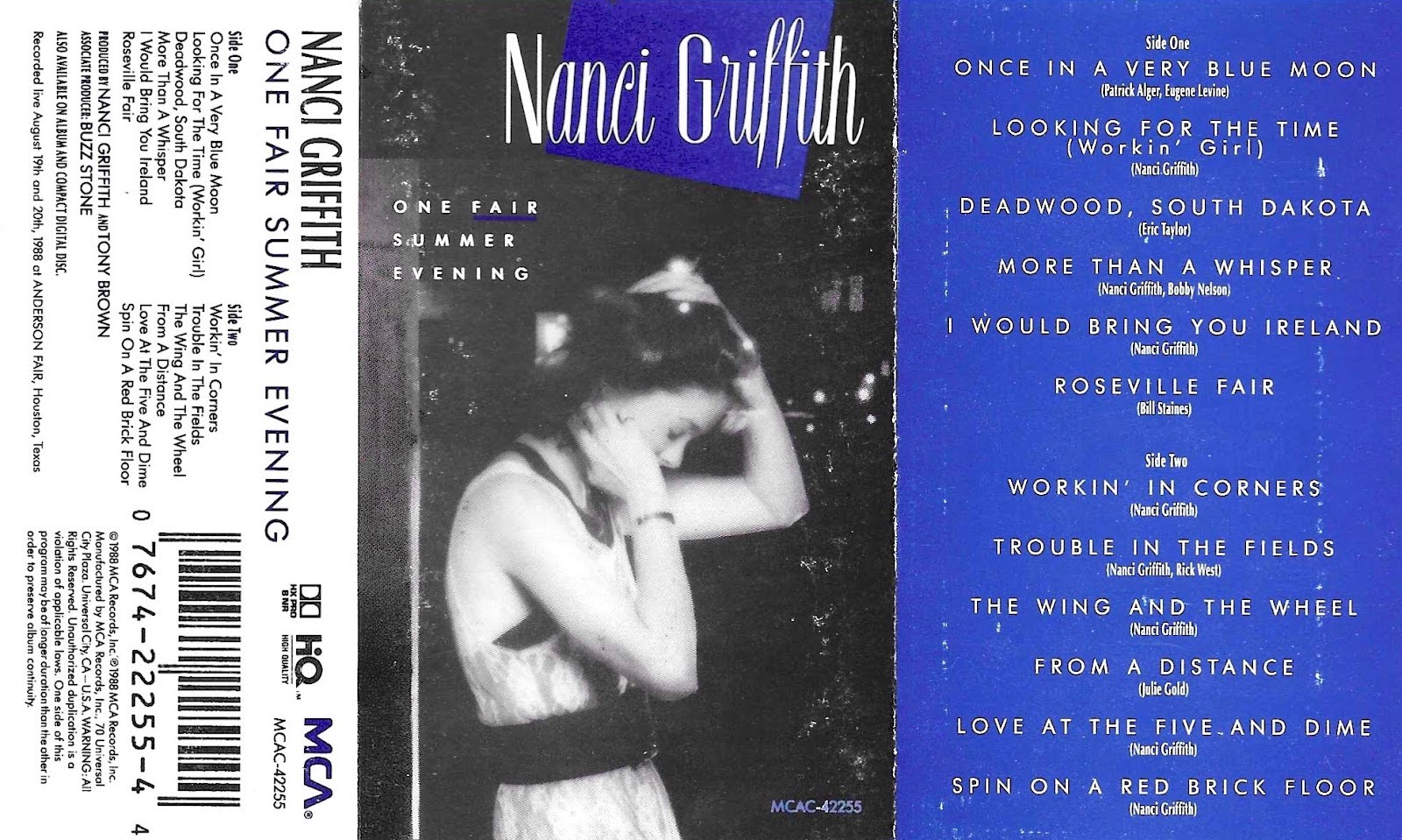
While introducing “Trouble in The Fields,” she jokes self-deprecatingly, “Most of my mother’s family came from way out in West Texas in a little town called Lockney, which is somewhere close to Lubbock, but not too close to Lubbock. Nobody likes to be too close to Lubbock.”
The crowd laughs, hysterically.
She continues with her squeaky soliloquy, one long run-on sentence without much pause for breath, “My great aunt Nettie Mae said that surviving the Great Depression on a farm was not easy and she understands why the young farmers nowadays are having such a hard time, because she went through it herself and the dust blew so hard during the Great Depression on her farm that she said she was afraid to go to sleep at night, because she was afraid the dust would blow so hard one night that she’d wake up the next morning and find herself living in Oklahoma and she by God didn’t want to live in Oklahoma.”
The audience, cackling louder now and showering Griffith’s gift of gab with rounds of applause, quickly quiets themselves as Griffith shifts her tone and launches into the song about her family’s trials and tribulations being farmers in Texas during the Dust Bowl, singing the words: “And all this trouble in our fields/ If this rain can fall, these wounds can heal.”
Sometimes, we look up in desperation as well, for any precipitation the sky can offer us.
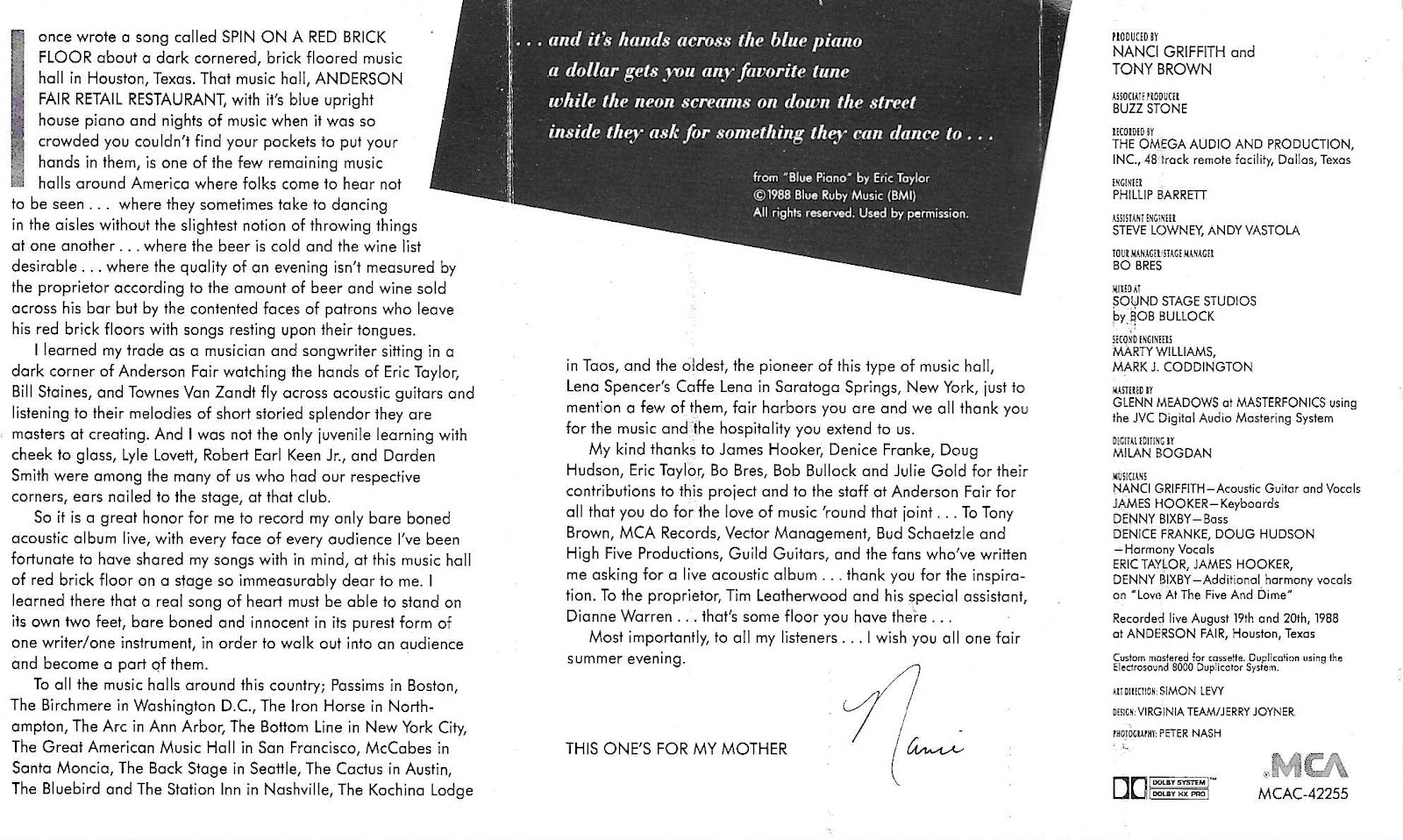
In the introduction to the next song, “The Wing and The Wheel,” Griffith tells her captive crowd, “There’s no need for any human being to ever be complacent.” The emotional whiplash might be too much to take, stark laughter swiftly shifting gears to deadpan seriousness, if the sincerity in the songs didn’t shine through with each passing line: “The wing and the wheel, they carry things away/ Whether it’s me that does the leavin’ or the love that flies away/ The moon outside my window looks so lonely tonight/ Oh, there’s a chunk out of its middle, big enough for an old fool to hide.”
Ten years later, in August 1998, Griffith’s relationship with her home state had become fraught. She wrote and sent letters to every major newspaper in Texas – the Dallas Morning News, the Houston and Austin Chronicles, the Austin-American Statesman, Texas Monthly – after a poor critical reception to her album Other Voices, Too (A Trip Back to Bountiful), released the month prior. In her letter, she defiantly rails, “There has always been a certain amount of pathos within artists who leave their sacred bountiful homes of birth for the benefit of preserving their own belief in their art—especially in cases such as my own where my native soil that I have so championed around this globe has done its best to choke whatever dignity I carried within me.” In the probing missive, she references Thomas Wolfe, whose own novels so severely damaged his reputation in his hometown of Asheville, North Carolina – which last year was decimated by the historic flooding of Hurricane Helene – he never returned.
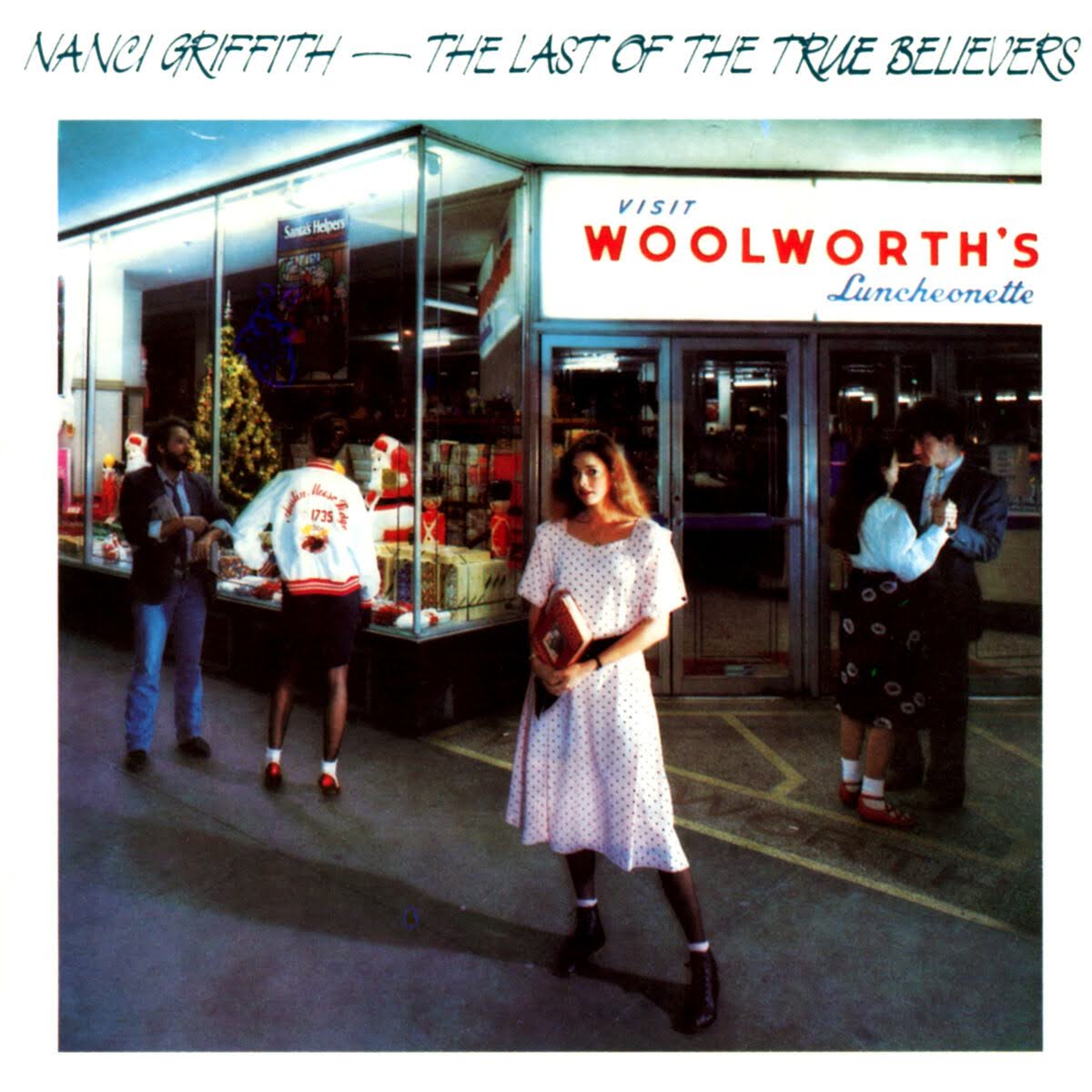
The full moon in July is otherwise called a “Buck Moon,” named for the time of year the male deer’s antlers grow anew and hunters can track them more easily midday. This year, the Buck Moon swung across a fair, summer evening sky over Texas on July 12th, barely a week after the floods. That night Luke Borchelt, a country musician and singer-songwriter from Maryland, was seated at a bar in Austin. The night prior, he had performed at Parish, a club in the heart of the state’s capitol, right near where a Woolworth’s once stood at Sixth Street and Congress Ave. The very same shop Griffith sang about in her “Love at The Five and Dime” – and is pictured in front of on the album cover for The Last of The True Believers.
After striking up a conversation with a local patron at the bar, Borchelt was asked, “You’re a country singer? Could we do a concert tomorrow to raise money?” Borchelt agreed. So it often goes with Texans: forward, empathetic and community-oriented. Prior to becoming a full-time musician, Borchelt worked for Mercy Chefs, the Virginia-based, disaster relief non-profit.
“I managed logistics and the distribution of meals in disaster areas. That was my passion. It’s also where I got my musical start. After hours, I would play for the chefs. Disaster is a part of my story.”
As Borchelt recounts his journey, it sounds like a country song. There’s a rhythm to his speech that’s musical. He tells me “…there’s a stereotype of ‘badass’ Texans,” but in the wake of the floods, the “Every Rain” singer says, “I can’t say enough about the amount of people that showed up. We asked them ‘What brought you here?,’ and they would say, ‘I’m a Texan. We just show up.’”
After his performance in Austin, Borchelt headed to volunteer with Mercy Chefs, who had stationed themselves at a church in Kerrville to prepare and serve meals to evacuees, first responders, and search and rescue teams. Since the intense rains fell on July 4 in the central part of the state, 136 people lost their lives – 116 of which were lost in Kerr County.
In the flash flood’s waters, which crested at 30 feet, lay Camp Mystic – a girls’ summer camp situated alongside the banks of the Guadalupe River, northwest of Seguin. It was there that 27 people, counselors and campers, mostly children, died during one of the most tragic natural disasters in recent memory.
The six different flags that have waved over Texas throughout its history – some more star-spangled than others – have always flown over a proud people. When I speak to Mercy Chefs’ Ashbi Wilson, the managing chef on the deployment teams in Kerrville and Ingram, it’s no surprise she’s proud of her Texas roots. She lived in Kerrville for eight years before relocating southeast to her current home in Wimberley. At 21 years-old, before she became a chef, she spent a summer as a counselor at Camp Mystic, based on the recommendation of a professor at the local college, Schreiner University.
Regarding Camp Mystic she recalls, “Mystic is a really special place. Everybody was so warm and welcoming. Everybody was really just there to be encouraging and to have fun, and to help these girls, growing up to be young women.”
Hours before she got the call to deploy to Kerr County in early July, her bags were already packed. “It was a lot more personal this time, so I was ready to go,” she tells me. “Disasters are always both devastating and inspiring at the same time. So, even though there’s been so much heaviness and devastation around the lives and the places lost, it’s still really rewarding and inspiring to watch the community, and people from all over the state, and the first responders from all over the country and all over the world come in and do the work that’s needed.”
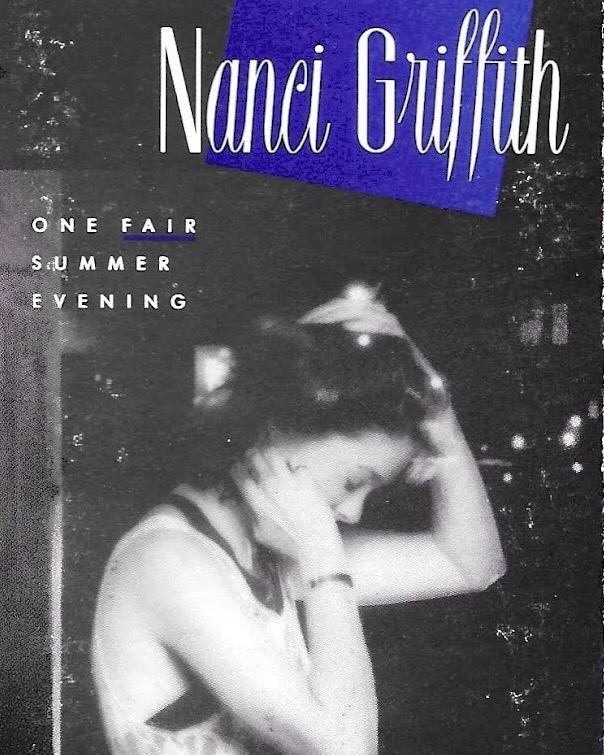
If these rains can fall, these wounds can heal.
Thousands of Texans called FEMA for assistance, and in the days following the torrential downpours, those calls were left unanswered, leaving recovery efforts largely in the hands of local authorities and volunteers. Firefighters from Mexico, a nation whose flag once flew over Texas, travelled north to Kerrville, and served a critical role in search and rescue operations. Earlier this month, after several Texas lawmakers fled the state in protest of a vote in the State Senate to gerrymander congressional districts along racial lines, one of their peers called upon a different federal agency, the FBI, to bring them back home. Is it any wonder why someone with such deep Texas roots as Nanci Griffith would disavow her home state?
Simultaneously, from where I write in Southern California, taqueros in East Los Angeles, farm workers in Camarillo, and day-laborers in the parking lots of Home Depots strewn across the city are being hunted like bucks at midday by armed and masked agents of the state, taken into federal custody to be deported to Tijuana, where there are now makeshift slums filled with deportees. In January, Mexican firefighters again headed north to volunteer to battle the blazes that burned across various pockets of the sprawling metropolis. Fire and I.C.E.
The desperation and helplessness one is inclined to feel while watching disasters both natural and unnatural unfold can be crippling. You don’t know how to do anything but languish in hopelessness and hang your head in shame, but as Wilson says, disasters can be both devastating and inspiring, no matter which way you look. Oftentimes, we turn to music to guide us through the dark and remove us from our solitude.
A live record gives its listener a glimpse into a communal space from afar, a moment captured crystalline and pure. Griffith’s One Fair Summer Evening served as my reminder that, not only in Texas, but everywhere a human draws breath, that “there’s no need for any human being to ever be complacent…” After all, “if these rains can fall, these wounds can heal.”
Donate to support flood relief in Texas by giving to the Community Foundation of the Texas Hill Country here. Learn more and support Mercy Chefs here.
Scans by Shane Greenberg, That Scans.
You Gotta Hear This: New Music From Katie Boeck, Ben Garnett, and More
You’ve reached the end of the week and, for your reward, we’ve collected a superlative handful of brand new videos, visualizers, and songs from roots music spheres.
Kicking us off, actor and indie-folk singer-songwriter Katie Boeck puts yearning “almost-love” in the spotlight with “Dust.” It’s a lovely, contemplative track that showcases that Boeck is equally at home in indie-tinged Americana as she is on a Broadway stage. Continuing in a similar context, with tender harmonies and fingerpicking as a sound bed Canadian folk duo Ocie Elliott also consider the messy, uncertain, shifting sands of loving someone and the circular nature of giving of yourself to another in that most intimate way.
Guitarist and composer Ben Garnett announced his upcoming sophomore album earlier this week. Kite’s Keep arrives in October, heralded here with the first single, “Look Again,” and a live performance video of the bustling, prismatic track featuring Brittany Haas on fiddle and Ethan Jodziewicz on bass. It demonstrates the consistently thoughtful and outside-the-box approach Garnett takes in crafting solo acoustic guitar music that bridges jazz, bluegrass, new acoustic, and more.
The Far West, Los Angeles-based country strutters, tapped Dave Alvin as a guest for their brand new track, “Hope I Don’t Bleed.” Dropping next week on August 22, you can get a sneak preview of the vibing, psychedelic LA-canyons-via-swampy-bottoms tune below. And, wrapping us up, singer-songwriter Jon LaDeau draws inspiration from a long New York City to Bristol, Tennessee, drive with “East Tennessee Wrecker.” He’s joined by Emily Jackson on the new single and performance video, which features a lovely stripped down version of the track, unadorned and shining.
Whatever your favorite flavor of country, folk, and roots music, there’s something for you to enjoy herein. You Gotta Hear This!
Katie Boeck, “Dust”
Artist: Katie Boeck
Hometown: San Luis Obispo, California
Song: “Dust”
Release Date: August 15, 2025
In Their Words: “‘Dust’ came out of the ache of almost-love – the kind where someone lingers near your heart, but never fully arrives. I was thinking of the tortoise and the hare, but as a metaphor for emotional pacing between two people. It began as an ultimatum, but ended as an acceptance of what is – without clinging to what could’ve been. I recorded it with Shane Leonard (Anna Tivel, Humbird), a producer I’ve long admired, at his studio in Eau Claire, Wisconsin, live to tape, which was my first experience in that setting. Creatively, it was also an exercise in letting something be what it was in that moment, without all the modern temptations and expectations of perfection.” – Katie Boeck
Track Credits:
Katie Boeck – Vocals, guitars, songwriter
Joe Westerlund – Drums
Pat Keen – Bass
Paul Brandt – Keys
Shane Leonard – Drums, producer, mixing, mastering
Video Credit: Bella Mazzola, Twin Lantern Productions
Ocie Elliott, “By The Way”
Artist: Ocie Elliott
Hometown: Victoria, British Columbia, Canada
Song: “By The Way”
Album: Bungalow
Release Date: August 15, 2025 (single); October 24, 2025 (album)
Label: Nettwerk Music Group
In Their Words: “‘By The Way’ is a song about the beautiful mess of loving someone – choosing love not just in spite of challenging dynamics, but because of them. It’s a recognition that no matter how fleeting and uncertain the unfolding of a story may be, love is the constant that it always circles back to. The song was written after many months away on tour and it was one of the first melodies and chord progressions that came to me once I delved back into writing. Sometimes songs take a while to come into being, but this was one of those tunes that arrived almost fully formed.” – Jon Middleton
The Far West, “Hope I Don’t Bleed”
Artist: The Far West
Hometown: Los Angeles, California
Song: “Hope I Don’t Bleed” featuring Dave Alvin
Album: Everything We Thought We Wanted
Release Date: August 22, 2025 (single); September 26, 2025 (album)
Label: Blackbird Record Label
In Their Words: “I’d been kicking this one around for years, but could never find the arrangement I wanted to suit the lyrics. Aaron, Robert, and Brian really found the swampy vibe I couldn’t seem to. The bass puts this right in the pocket it needed to be, and having Dave Alvin tear a white-hot solo through it made it complete.
“Dave played this solo though my amp, which is a special little factoid for me. The amp is now blessed. My little Fender only has a volume and tone knob, and I used to tape the volume knob down at shows because the vibration of the amp would cause it to turn itself up as it rattled. I took the tape off in the studio. Dave likes things loud and either the amp turned itself up to 10 or he did, either way each take got louder.
“You can hear the amp being pressed to its absolute limit. I know he’s blown some bigger amps on stage, I was surprised my little amp survived. A few months after he laid down this solo, I saw him at the Astro Diner and mentioned we were listening back and ‘we think the amp turned itself up on you during the session’… he just looked at me and said, ‘No it didn’t.’ Anyway, this one is simply about being afraid of experiencing pain at death.” – Lee Briante
Ben Garnett, “Look Again”
Artist: Ben Garnett
Hometown: Nashville, Tennessee
Song: “Look Again”
Album: Kite’s Keep
Release Date: August 12, 2025 (single); October 10, 2025 (album)
Label: Padiddle Records
In Their Words: “‘Look Again’ is the first track on my sophomore studio album, Kite’s Keep. The album title loosely refers to this idea of a child’s inner world – a dreamscape where each song represents a different vignette of imagination.
“With ‘Look Again,’ I wanted the music to feel prismatic. As if to suggest an imaginative universe emerging from an ordinary one. I was interested in exploring, in musical terms, the idea that perception is never fixed. Like the old saying goes, ‘You never step in the same river twice’ – one also never sees the same thing twice. Any time we return to anything, it’s always different, with all things constantly in motion.
“On top of this, I had the immense joy of working with two musicians I deeply adore: Brittany Haas on fiddle and Ethan Jodziewicz on bass. Their performances brought the track to life in ways I couldn’t have imagined.” – Ben Garnett
Track Credits:
Ben Garnett – Guitar
Brittany Haas – Fiddle
Ethan Jodziewicz – Bass
Video Credits: Tessa Cokkinias – Cinematography
Ben Garnett – Video
Jon LaDeau, “East Tennessee Wrecker”
Artist: Jon LaDeau
Hometown: Brooklyn, New York
Song: “East Tennessee Wrecker” featuring Emily Jackson
Album: Chateau LaDeau
Release Date: August 22, 2025
Label: Adhyâropa Records
In Their Words: “‘East Tennessee Wrecker’ is a song that has been picking at me for a long time. Several years ago, I was traveling with my band from Brooklyn, NY to Bristol, TN to play at the Bristol Rhythm and Roots Reunion. It’s about a 10-hour drive and for some reason our navigation system was counting down the hours until we arrived at East Tennessee Wrecker. We didn’t know what that was, but discovered upon arriving in the area that it was a towing service that I believe has since changed names. For some reason that title got imprinted in my mind and as time went by the structure of a song began to reveal itself.
“I recorded the guitars, bass, and drums in my studio in Brooklyn and when the music felt right, I was lucky to have Emily Jackson come by and sing a duet with me to tie it all together. We sang together live into one mic and that’s what you hear on the album. I brought this version of the song to David Butler and he fleshed out the arrangement by adding a second drum set, a drum machine, and some sparse keyboard stuff. I’m really happy with how this one came out and I feel lucky that D. James Goodwin was available to really bring the performances we captured to their full sonic potential by mixing and mastering.
“At the heart of the song it’s really just acoustic guitar and vocals, so I wanted to capture a stripped down version as well. Aaron Cassara filmed Emily and I singing it at The Scratcher here in the East Village, NYC. I’ve been very fortunate to work out a lot of my songs here over the years during their Sunday night music series so it felt natural to capture a version of the song in the same way you would hear it live in a room that means so much to me. This song seems to reinforce the feelings of connection I have to my community. I hope that it lifts up anyone who gives it a listen.” – Jon LaDeau
Photo Credit: Katie Boeck by New Norm Studios; Ben Garnett by Natia Cinco.
Basic Folk: Joe K. Walsh
Joe K. Walsh grew up in Duluth, Minnesota, and became enthralled with the mandolin (his primary focus, currently) after hearing the first David Grisman Quintet record. His dad got the young Joe his own mando. He ended up getting very serious about the instrument and found himself studying at Berklee College of Music in Boston (where he is now on faculty in the string department). Joe, in fact, was the first mandolin student at Berklee in a town that is now flooded with amazing mandolin players. His already strong sense of community and collaboration led him to becoming a main player in the Boston scene with his string band Joy Kills Sorrow, and with the Gibson Brothers. He now resides in Portland, Maine, and plays solo as well as with Mr. Sun, a group led by fiddler Darol Anger.
LISTEN: APPLE • SPOTIFY • AMAZON • MP3
In our Basic Folk conversation, we talk about taking over at Berklee after the death of professor John McGann, a beloved trad player who recorded with David Grisman, Mark O’Connor, Tim O’Brien, and the Boston Pops, among others. Joe addresses the question of whether bringing folk music into a college setting is “academizing” it or perhaps “folking” music academia. He also gets into hot button issues like improv, simplicity, and restraint. And, of course, he finally reveals his true feelings about the “other” Joe Walsh. Joe’s new instrumental album, Trust and Love, is a peaceful listen in these wild times. I’m happy to know Joe and have already benefited from his friendship! He and his wife gave my family a ton of baby hand-me-downs that have proved so useful. Everyone has a friend in Joe. K Walsh.
Read our feature interview with Joe K. Walsh on his latest album, Trust and Love, here.
Photo Credit: Natalie Conn
Gimme That Old-Time
Non-Monogamy
At times frowned upon or occasionally slandered, covers are as deep-rooted as the songs and the emerald valleys that have produced them.
Indeed, covers stir discussion, spark research, and add another patch to the great heart-sewn embroidery of music. Fashioned in a similar vein to the original – that’s flattery. When a song circles across genre divides, well, that’s an enriching voyage.
The members of Kissing Other ppl – Rachel Baiman and folk duo Viv & Riley – see their endeavor not just as an individual artistic sojourn but as a larger opportunity to establish a collective conversation. Here, they’ve taken a handful of mostly rock and pop songs and blended, marinated, and sautéed them in unfamiliar flavors. The end results turned out nearer to their own identities.
“I grew up playing traditional Appalachian style,” said Riley. “This is not that!”
Baiman is a sincere and dogged lyricist, with a harmonious ear and a top contender’s punch. She grew up in Chicago, with a factory-made violin in her hands and an insatiable curiosity for why and how music could conform and contort to her swiftly evolving moods. Somewhere along the line, she started getting serious about music and purchased a John Silakowski five-string fiddle on a lengthy installment plan. She arrived in Nashville at age 18, riding fragile finances. Slogging on foot, lugging her fiddle in a hard, cumbersome case, she lacked the extra dollars to hail a taxi. Her odd jobs were many: dog walking; catering; reading novels and writing summaries for a sociology professor; she once even held a job organizing a comedy contest. But a fearless, tenacious sense of purpose compelled her to stick with music.
Pondering all of these circumstances in her heart, Baiman released several persuasive projects, including Shame (2017) and Common Nation of Sorrow (2023). Riley Calcagno, one half of the contemplative folk duo Viv & Riley, added stringed support and pre-production assets to one of Rachel’s albums.
Subsequently, Baiman asked Riley and Vivian Leva (the other half of the duo) if they’d be willing to join her on tour, where long hours on the road were spent in between gigs consuming, swapping, and contemplating music. Baiman’s traditional background taught her how to fully perceive a recording – whether an old fiddle tune or multi-generational, passed down ballad, or even a contemporary pop song – to not only hear it superficially, but to visualize its promise. Through prolonged stretches of asphalt and expressway, she’d oftentimes wonder what she, if given the opportunity, could bring to a certain song.
@kissing.other.ppl♬ original sound – kissingotherpplband
“The idea stems from Rachel’s musical generosity and curiosity and the extended times in those van rides,” said Riley. “Eventually, the songs included were the ones that we’d all individually had been listening to and were moved by. Songs that had stopped us in our tracks at different realms of our lives. Songs that hit us emotionally or otherwise… spontaneously contributed in the week that we recorded them.”
Some of Riley’s earliest memories are of his father’s fondness of traditional music. His father played the guitar, fiddle, mandolin, and banjo. At age 3, the younger Calcagno expressed interest in the fiddle. Though he was raised in an unrelentingly urban environment in the heart of Seattle he was never far from the folksy hospitality of music: square dances, jams, and potlucks. At the Wintergrass Music Festival in Bellevue, Washington, he formed connections with musicians originating from the sparsest, most countrified swaths of the state.
“I discovered an authentic-feeling bluegrass scene in the state and an old-time rural music scene on the West Coast that was kept going by people living in cities,” he explained, “and I don’t see that at all as contradictory.”
Like many other kids his age who grew up in Seattle, beginning in middle school, Riley burned liberal hours listening to local indie rock, though the attachment he had made with traditional music would override all else. He met Vivian Leva at a music camp in the Seattle area which emphasized the cultural importance of preserving long-standing traditions.
“I was a fan of Viv’s parents’ music,” said Riley. “We started playing music right away. Viv is a gifted songwriter. We started passing ideas back and forth. That was eight years ago.”
Vivian Leva was born and raised in Lexington, Virginia, in the Shenandoah Valley close to the abounding cultural and geographical influences of Charlottesville, Roanoke, and the Blue Ridge Mountains. It’s a small town with a deep worship of bluegrass and old-time narratives.
“Before I was born, it was a big hub of old-time traditional music,” said Viv. “Young people moved here for the rich, blossoming scene. My dad came here at 18 and stayed forever.”
Viv’s father, too, took a particular interest in the fiddle, traveling to neighboring counties and states to observe and jam. Her mother sang and guitar-picked, emulating and scrutinizing the local and regional ballads she had fallen in love with. They attended old-time fiddler’s conventions as a family. And when her parents formed a duo and headed out on the highway, sometimes she would share in such jaunts first-hand.
“When I was little I went on tour with them for a bit,” said Viv. “As a teenager, I was playing in my dad’s bands. As a kid he would bring me up to sing a song on stage.”
Certainly, music has long filled the souls of Rachel, Viv, and Riley with good things – and Kissing Other ppl is a remembrance of affection as much as it is a representation of impression. Indeed, Baiman said that Kissing Other ppl is a natural extension of her – and her counterparts’ – inquisitiveness, their attempt to understand the mysterious processes of expression, meaning, and memory.
“In reality,” said Rachel, “I don’t think any band or musical project should attempt monogamy, because you miss out on so many opportunities to learn and grow and bring new inspiration back to your main role.”
Similar to Rachel, Viv finds original songwriting to be a sacred, mysterious place to dwell. But she also believes that covers are a part of the whole process of an artist’s maturity, the recognition of the music of one’s friends, mentors, neighbors, and across-the-board community.
“There can be a stigma about covers,” she said. “You can’t make it your own. You are not creative enough to make your own music. It’s a shortcut. It’s a cop out. But as someone who has written a lot of songs and released a lot of records of original music, and plans to do so in the future, I don’t see it that way. It is an acknowledgment of how being inspired by other people’s music is such an important part of creating your own music. You can’t make your own music in a vacuum.”
“Anytime that you are playing a song, you are creating it again in the moment, and re-interpreting in your own way,” added Riley. “Whether it is a cover or an old traditional song, you still have the power to sing it and do it in a way that really moves someone.”
Baiman said the intuitive, empathetic nature of the type of music she plays requires that she be an attentive observer as well as a cordial, broad-minded learner – prerequisites for a collaboration of this sort.
“I think that having a background in old-time and fiddle music in general really prepares you to be a musician who listens,” said Rachel. “If you approach any musical situation with the mindset of, ‘Can I do something to help support the group musically here?’, that goes a long way.
“Old-time really prepares you for the idea that your best contribution might be not to play at all. The bar is really high for joining in, you have to make sure you’re adding something that isn’t already there, and you’re not dragging down the groove. That’s part of the etiquette of informal jamming and it translates to professional playing.”
A fine cover such as the group’s rendition of Wilco’s “Ashes of American Flags” not only illuminates a previous desire, elevating or enriching it with brand new urgency, but in some fashion it obliges the total re-evaluation of the original.
“There are people who are not able to handle ‘Ashes of American Flags’ because of the context, or they come from a different generation, or they don’t like Jeff Tweedy singing it,” said Riley. “Why not give a song like that another chance or give it another life? If you have a song that’s fun, or one that hits hard, emotionally, lyrically, or harmonically, maybe you can add to it, instead of just burying it on a playlist.”
Riley notes that many of the greatest records and biggest chart sellers are in fact cover-centric productions, though they might not have been advertised or promoted as such at the time. Many great albums are rife with songs written by others, sometimes entire roomfuls of songwriters on Music Row. Many memorable albums, such as Bob Dylan’s 1962 self-titled debut, only have a small number of originals; among the traditional folk and blues arrangements, Dylan’s had but two.
Indeed, Kissing Other ppl simply builds on a long tradition of artists rearranging songs that they like and then reinserting them back into the public sphere of approval.
“We seem to be obsessed with originality in our current moment and society,” said Riley. “But we are also at a time when art and – the pursuit of it – is less funded and less valued monetarily than ever. So many of the great records that we love are cover records. Ours isn’t heavy-handed.”
Perhaps one sterling example of a cover album that marvelously nudged old material into fresh fields was Tim O’Brien’s Red on Blonde, on which O’Brien grabbed a handful of Dylan songs, tinkered with their framework, and dragged them into bluegrass brightness. Many of these songs have stuck around since the album’s release in 1996 and bluegrass buffs routinely call out titles such as “Señor (Tales of Yankee Power)” and “Farewell Angelina.”
One of the record’s most memorable tracks is a rendition of Jason Molina’s “Hold On Magnolia,” which draws out the spookily and eerily beautiful essence of the inscrutable artist’s mystifying original. Rachel’s fiddle punctuates the abstract stylishness with characteristic splendor and aplomb.
“Jason Molina [1973-2013] was one of the greatest songwriters,” said Riley. “He grew up in Lorain, Ohio, and he went to Oberlin College, where I went. He had a rough life and died of alcohol-related complications. He left so much amazing music behind… if even one person hears our version and goes and listens to his records then it is a job well done.”
Alluding to Molina, Viv noted the deferential nature of covers and their special reward.
“That’s the cool element of doing a record of covers,” she said. “You can inspire people with that special song that resonates and if they haven’t heard of that artist, they can go back and listen to their work.”
On both “Hold On Magnolia” and “Ashes of American Flags,” Viv found herself in the new position of playing the drums. She sensed the two songs required the presence of drums and their inclusion was inspired by her simple desire to test the unfamiliar.
“One of the incentives I had to go to guitar lessons when I was younger was that my teacher would let me play drums for the last ten minutes of the lesson,” said Viv. “During COVID, Riley surprised me with a drum kit. He got an electric guitar. We were having fun during the lockdown in our basement. We were doing less folk music, and experimenting with instruments outside of the immediate folk genre. So, I took a crack at it.”
“I think it is a testament to the spirit of making the record that we felt comfortable putting her on the drums,” added Riley. “[Producer] Greg D. Griffith made the snare drums sound huge and awesome, adding a big element to the tracks.”
One song that Viv introduced to the project was “Born to Lose” by Waylon Payne, and the diversity in these respective arrangements is startling: Payne’s original was supported by a complete country band; the new offering is sagaciously stripped down, extracting every syllable of bitterness, sorrow, self-loathing, and private turmoil from the lyrics.
“I had been particularly into this artist, Waylon Payne,” said Viv. “His vocals are really fascinating to me. His ornamentation is really incredible. I spent a lot of time trying to figure out what he was doing. I was definitely interested in trying to get his vocal ornaments similar, because I think that they are really beautiful.”
The spacey, moody “Where’d All the Time Go?” by Doctor Dog was another one of Rachel’s proposals.
“That is a fun song to do as a trio, because of its echoing harmony parts,” said Viv. “I would have never picked that song for myself to learn. That’s what made it challenging. It took me outside of my vocal comfort zone, and that was a fun challenge for me.”
The name of the band, Kissing Other ppl, is a teasing affirmation of one of the pop songs covered on the album, a soft, mischievous Lennon Stella song released in 2020.
“It has a fun and flirty vibe,” said Riley, “but it also gets to something funny and true about relationships. It captures the lightness of the experience of playing music and hanging out, and not taking yourself too seriously. It was Rachel’s idea and she stuck with it. It is awkward and funny, and why not? Life is short.”
Baiman said the namesake reveals a good-natured admittance of the diversionary quality of art.
“Coming from two different projects that are based in original music and collaborating on cover songs,” said Rachel, “we chose the band name as a playful nod to the idea that we were cheating on our own projects by trying something different and new.”
The trio intends to take their reincarnated versions on the road. Beyond that they have no fixed plans to continue – or, for that matter, discontinue – sewing and hemming their skills and interests together.
Indeed, sustained in its own special love and humility, kissing other ppl expresses not just innovative lyricism and beautiful buzzes, but a powerful sense of understanding. What Rachel, Viv, and Riley all agree on is that the genre or style of its communication is less important than the nourishing energy and want that necessitated its assembly.
“In the end, a lot of the songs are ambiguous,” said Viv. “It is hard to say exactly what some of the songs are about. We are not spelling out what you should be thinking or feeling. It’s just cool to see how other people are able to communicate things in totally different ways than how you would communicate them. But somehow it still hits you.”
Photos courtesy of the artist.

